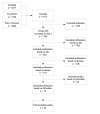Which intervention characteristics are related to more exposure to internet-delivered healthy lifestyle promotion interventions? A systematic review
- PMID: 21212045
- PMCID: PMC3221341
- DOI: 10.2196/jmir.1639
Which intervention characteristics are related to more exposure to internet-delivered healthy lifestyle promotion interventions? A systematic review
Abstract
Background: The Internet has become a popular medium for the delivery of tailored healthy lifestyle promoting interventions. The actual reach of Internet-delivered interventions seems, however, lower than expected, and attrition from interventions is generally high. Characteristics of an intervention, such as personally tailored feedback and goal setting, are thought to be among the important factors related to of use of and exposure to interventions. However, there is no systematic overview of which characteristics of Internet-delivered interventions may be related to more exposure.
Objective: The present study aims to identify (1) which potentially exposure-promoting methods and strategies are used in existing Internet interventions, (2) which objective outcome measures are used to measure exposure to Internet interventions, and (3) which potentially exposure-promoting methods and strategies are associated with better exposure.
Methods: A systematic review of the literature was conducted based on the Cochrane guidelines. Papers published between 1995 and 2009 were searched in the PubMed, PsycINFO, and Web of Science databases. In total, 64 studies were included that reported objective exposure measures such as completion of an initial visit, number of log-ins, and time spent on the website. Information about intervention-related characteristics (ie, interactive behavior change strategies, interactive elements for fun, peer or counsel support, email/phone contact, and regular updates of the website) that could potentially contribute to better exposure and objective exposure outcomes were abstracted from the studies and qualitative systematic descriptive analyses were performed.
Results: The results showed that a large variety of behavior change techniques and other exposure-promoting elements were used in the interventions and that these methods and strategies varied for the various lifestyle behaviors. Feedback, interactive elements, and email/phone contact were used most often. In addition, there was much variety and a lack of consistency in the exposure measures that were reported. Of all the categories of intervention characteristics that may be associated with better exposure, there were indications that peer and counselor support result in a longer website visit and that email/phone contact and updates of the website result in more log-ins.
Conclusions: Results of this qualitative systematic review indicate that of all intervention characteristics that could potentially enhance exposure, only peer support, counselor support, email/phone contact with visitors, and updates of the intervention website were related to better exposure. The diversity of intervention methods used and the inconsistency in the report of exposure measures prevented us from drawing firmer conclusions. More research is needed to identify whether other characteristics of Internet interventions are associated with greater exposure.
Conflict of interest statement
None declared
References
-
- Tu HT, Cohen GR. Striking jump in consumers seeking health care information. Track Rep. 2008 Aug;(20):1–8. - PubMed
-
- Fox S. Online health search. Washington, DC: Pew Internet & American Life Project; 2006. Oct 29, [2010-12-23]. 5vBzrOQNC http://www.pewinternet.org/~/media//Files/Reports/2006/PIP_Online_Health....
-
- Brouwer W, Oenema A, Raat H, Crutzen R, de Nooijer J, de Vries NK, Brug J. Characteristics of visitors and revisitors to an Internet-delivered computer-tailored lifestyle intervention implemented for use by the general public. Health Educ Res. 2010 Aug;25(4):585–95. doi: 10.1093/her/cyp063.cyp063 - DOI - PubMed
-
- Brug J, Oenema A, Campbell M. Past, present, and future of computer-tailored nutrition education. Am J Clin Nutr. 2003 Apr;77(4 Suppl):1028S–1034S. http://www.ajcn.org/cgi/pmidlookup?view=long&pmid=12663313 - PubMed
Publication types
MeSH terms
LinkOut - more resources
Full Text Sources
Medical


